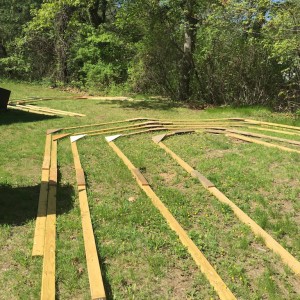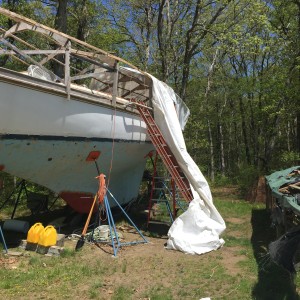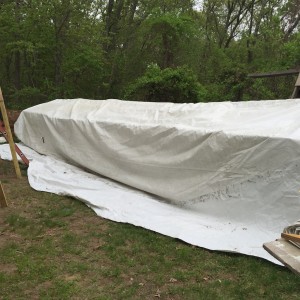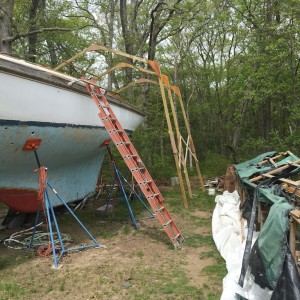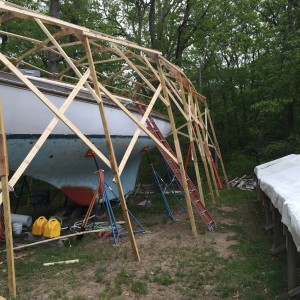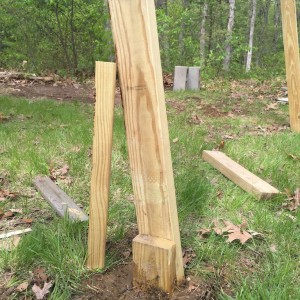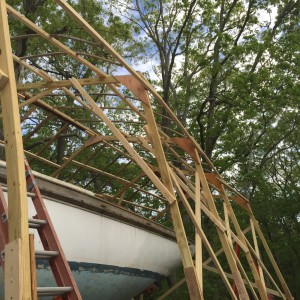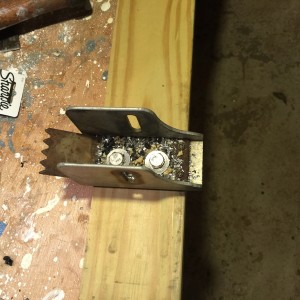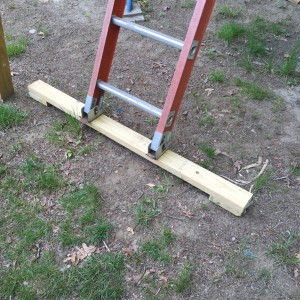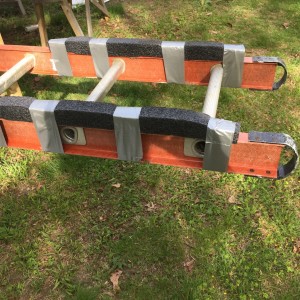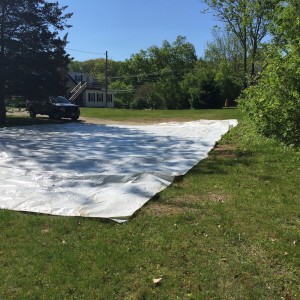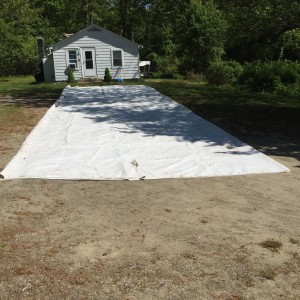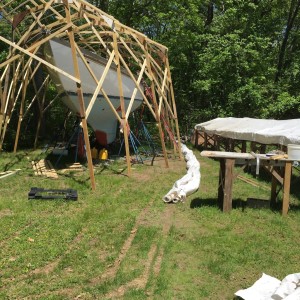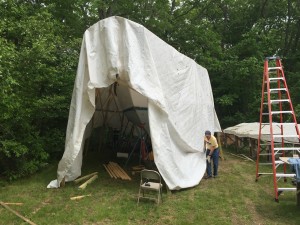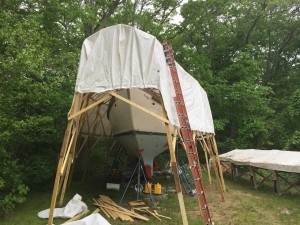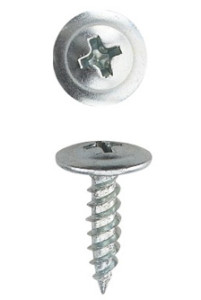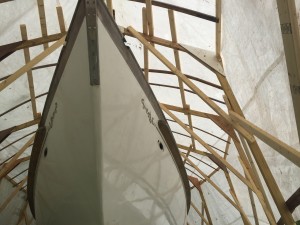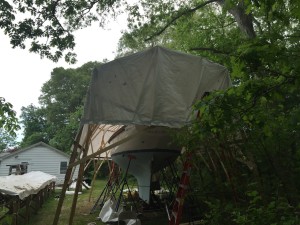5/26/15: Frame and Tarp
With the eight trusses completed, it was time to remove the old frame and cover and assemble the new frame and cover.
The following photo shows the old cover coming off, revealing the old frame. On the right, you can see the sorry state of the tarp covering the masts.
The old cover was used as a nice upgrade for the cover of the masts. The photo below shows the old cover over the masts, where much of the extra has now been trimmed.
The trusses were moved into position one by one, and tacked together temporarily.
With all eight trusses in position, the temporary bracing (1x4x8s) was replaced with a more robust system consisting of 2x3x8s and 2x4x10s, as shown in the photo below.The side members of the trusses are 14.5 ft in length, so much of this work required a helper and frequent use of the 12-ft stepladder. Everything you see in the photo below is fastened with external drywall screws of various lengths. The 3-in screws required pre-drilling.
The old frame was connected to the boat by screws that passed through the bottom of the trusses horizontally and into the rub rail. The old system survived at least one hurricane, a handful of nor-easters, and many heavy snows with no issues. The new system must be equal to the old in this regard. The new frame is nowhere connected to the boat, so it must be anchored somehow (its weight alone is not expected to be a sufficient “anchor”). A post-hole digger was used to dig 14-in holes near the bottoms of some of the trusses. Then, 18-inch pressure-treated 2x4s were installed, and then the exposed ends were screwed to the bottoms of the trusses. So far, four such anchors populate the port side, with three on the starboard. Time will tell if more of these anchors will be installed.
The gaps in the roof were too large, so athwartship ribbing was constructed from old 1x2s and 1x3s.
Before covering the frame, the boat ladder was modified to be better suited for both fastening the new cover to the frame and for climbing aboard the boat while working on the toe-rail and rub-rail. Some of the photos above show that the ladder previously had a large brace at the top, which, when leaned against the rub-rail, made for a very secure system for climbing aboard. The large brace, however, will lose much of its utility should the rub-rail be removed. Moreover, this brace would be a liability while using the ladder to work on the cover. With all this in mind, and not wanting to lose the stability provided by the brace, the feet of the ladder were bolted to a pressure-treated 2×4 as shown in the following photos.
The new tarp is 40×60 ft and was purchased about a year ago from someone who had used it as the liner for a backyard ice rink. Discouraged by the recent mild winters, he abandoned his dreams of playing backyard hockey and sold the tarp for $100. The following photo shows the tarp spread out in the front yard.
Next, the tarp was folded in half by folding each of the two long sides to the centerline. Each side was then rolled to the center, making a 60-ft long double roll that was tied by short lines every 10 or so feet.
Next, the tarp was dragged to the backyard and laid alongside the boat, as shown in the following photo.
The tarp is very heavy (perhaps 200+ lbs). Lines were attached in five places and thrown over the port side of the frame, and two people aboard pulling the ropes and two on the ground pushing with long boards were able to get the tarp up on top of the frame with relative ease. Once the tarp was centered, the sides were rolled down (with some encouragement), resulting in the scene in the photo below.
Not shown in any of these photos is that strips of wood were connected to the trusses along the port and starboard sides, about 10 ft from the ground. The cover was fastened to these strips, and then other strips at the front and back, and then the tarp was trimmed, as shown in the photo below.
Incidentally, the tarp is connected to the frame by means of 1/2-inch, self-tapping screws with washer heads, like the ones in the following photo. With the ladder, it was possible to get these screws into the frame almost everywhere, with the exception of near the center of the top.
Connecting the tarp in this way provides a watertight, rope-free system that is very secure. The tarp does not flap around because it is connected to the frame not only at its perimeter. This system greatly reduces abrasion (by means of reducing motion).
Observations will be made during blustery conditions to determine the need for more bracing, anchors, screws, and so on, but for now it’s a wrap.
The following two photos are self-explanatory.
